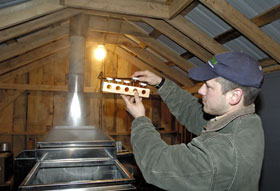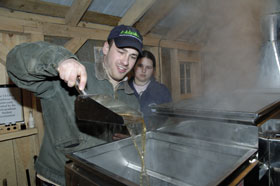Sweet Taste of Success For
Students Producing Maple Syrup
 |
| Geoffrey Picard, vice president of the Forestry and Wildlife Club, makes maple syrup at the UConn sugarhouse. Above, he looks at the different grades of syrup; below he points to the chamber where the finished syrup collects. |
|
Photos by Dollie Harvey |
 |
 |
|
Above,
Picard uses a hydrometer to measure the density of the syrup; Below, he uses
a paddle to check on the progress of the syrup, as Christine Murcott, also a
member of the Forestry and Wildlife Club, looks on.
|
 |
On the outskirts of campus, off Horsebarn Hill Road, stands a tiny, one-room wooden cabin. Steam billows from the smoke stack rising from the tin roof. A sign for “100 percent Connecticut Maple Syrup” hangs on the door.
The snow was still on the ground as the shack opened March 24 for the last sugaring of the maple syrup season, led by Geoffrey Picard, a senior majoring in natural resources management and engineering and vice president of the Forestry and Wildlife Club.
The club, which has about 20 members from many different majors and disciplines, received funding from the Undergraduate Student Government to construct the new sugarhouse and pay for equipment, including an evaporation machine, three sugar-holding tanks, and tubing.
Last year the club made three gallons of maple syrup; this year they made more than seven, says Picard.
“We just do as much as the club can handle and that’s it,” says Edward Belinsky, the club’s president and a junior majoring in natural resources management and engineering. “We hang out, we have a good time, and when it all boils out, we go home.”
Picard has been sugaring since he was 12 years old. His father took him to a sugarhouse in his hometown, and he liked the smell so much he tried to make it on his stovetop at home. Eventually he bought a home evaporator.
“I love the smell of the steam,” he says. “It could be any time of the year, and I’ll smell something and think, ‘that smells like sap’.”
The club draws the sap from a sugar bush – a collection of sugar maples – on a hill on Old Turnpike Road in Storrs. Since the tubing leads to a tank at the bottom of the hill, gravity moves the sap naturally.
Sugaring is best done when the days are above freezing and the nights are below. The season usually lasts from mid-February to late March.
“It’s the thaw that pushes the sap out of the trees,” Picard explains. “Once you get a week of 50 degree temperatures, the buds start bursting on the trees, and the sap gets a yellowish tint. Then you know the season is over.”
The students pump the sap from the collection tank into a portable tank on the back of a pickup truck. They then move it to the sugarhouse, where they pump it into the main tank attached to the evaporator.
The sap flows into the back pan, where it begins to boil. As water evaporates from the sap, the level of liquid within the evaporator drops. When it drops to a certain level, a valve automatically opens, letting more sap inside.
The steam from the process smells sweet and earthy.
“Sometimes we just close everything and let the shack fill with steam,” says freshman club member Christine Murcott. “After a few minutes, you can’t see anyone’s face, even with the lights on.”
Once the sap has been boiled into syrup, the students filter out any bugs and nitre (a white film that coats the syrup) to create the final product. Because sap is made up of 98 percent water and 2 percent sugar, it takes 40 gallons of sap to make one gallon of syrup.
Maple syrup is sold in different grades, from light to dark. Fancy light is the most expensive and the hardest to achieve, says Picard. “The longer you let the sap sit in the tank, the darker the grade you are going to get. Same day tap gives you fancy light syrup.” Because the club collects the sap only once or twice a week, the syrup it makes is dark amber.
The syrup is sold at the sugarhouse.
“The word is out,” says Picard. “We’ve sold over $200 worth of syrup so far this season.”

